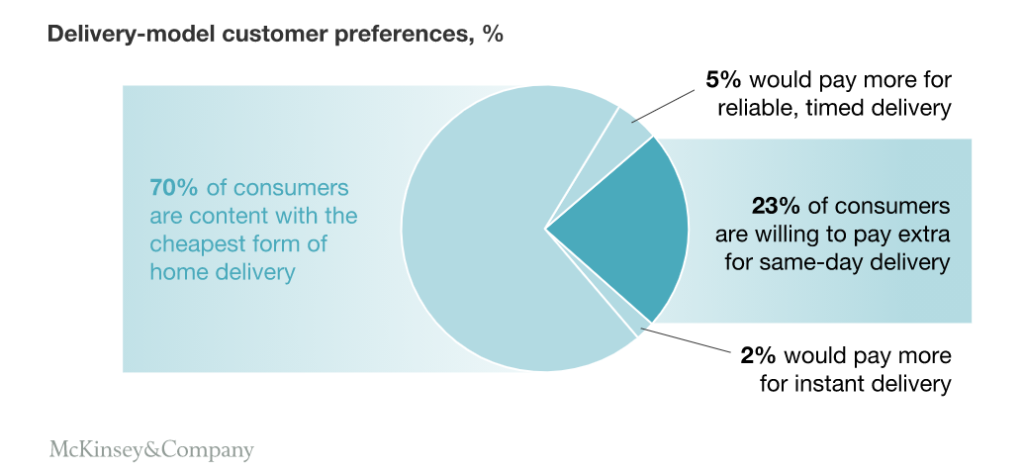What is the last-mile delivery and why it’s important?
Imagine you ordered something you wished for a long time. You go to the website, finally place the order, and get the estimated delivery time. And you wait. But as the waiting gets longer, the uneasiness is growing when the delivery does not match the expected arrival time. It’s not fun. And with technology advancing, customer expectations are also on the rise. Favorably, whether you run a fleet of cars or on-demand drivers, last-mile delivery tracking ensures you give your customers more accurate ETAs and drivers are operating safely.
What is last-mile delivery?
Last-mile delivery is the last stage of the delivery process, where a package moves from one location to its final recipient. Traditionally, the package would be moving from a distribution hub or warehouse. With the latest developments in the logistics field, packages can often travel directly from a retail center or grocery store. To keep up with the orders, their status and get them delivered fast, companies should consider optimizing the driver routes.
You can find it under different names, such as last-mile transportation, final mile delivery, or last-mile logistics. But last-mile delivery is the most common.
Why last-mile delivery is important for your company?
The last-mile delivery is one of the most important parts of the delivery process. Even if handled by a third party, it has an enormous impact on how the client perceives your company. And whether they decide to come back for other orders.
The last mile delivery accounts for 53% of your total transport costs. This means optimizations in this area could account for huge savings on your total freight costs. Of course, you should balance route optimization with customer experience in mind, as they are your most important asset.
Last-mile logistics have an important focus since in many cases, this is a key differentiator for companies. And with the surge of online orders during the pandemic in 2020, e-commerce sales are expected to reach $3.914 trillion.
The biggest challenge companies are facing today, with the proliferation of e-commerce, is customers expect their delivery yesterday. Two income families, heavy densities, and urbanization pose the biggest concerns. They make getting the cars into the delivery areas difficult. Real-time events, congestions, accidents also play a huge part in the last mile delivery process adding to the final costs. Fortunately, more businesses and customers look to technology to take advantage of the automation and information possibilities.
Adapt to new trends
Fulfillment timetables are changing. Consumers want faster deliveries, and shippers need to move more products at a faster pace. You cannot afford to lose time but increase the speed. As a consequence, last-mile logistics are in a perfect position to become an important part of this push toward faster fulfillment. Among millennials, consumers are more willing to pay for same-day delivery with 30% more. An overwhelming majority are willing to pay extra for guaranteed delivery.
Perfecting the last-mile delivery to meet and exceed customer expectations is critical to providing a delightful customer experience.

Use a route planner for more accurate ETAs
Each driver has a route to follow and in an ideal world, they are short, straightforward, and easy. But in reality, a route depends on a number of factors, which can add to the total delivery time and costs. In high-density urban areas, traffic congestions are unpredictable and the close addresses can take as much time as delivering to rural areas with fewer drop-offs.
Logistia helps you optimize routes for every driver, factoring time, location, vehicle capacity, distance, and traffic to calculate the best route.
Offer a delivery slot selection
Give your clients more control of the delivery and allow them to choose the delivery date based on your rules. 56% of consumers in a study asked for more visibility in the delivery process.
Logistia can help you route all addresses of your customers in the time interval they asked for.
Improve customer experience
It’s easy to make small improvements with a great impact on customer experience. With Logistia Route Planner you can go beyond providing the clients with just a tracking number. Customers are able to see where the driver is, contact him/her, and receive a notification when they are next in line.
Future trends
Delivery by drones, self-driving cars, and robots
Autonomous vehicles will definitely impact last-mile logistics. All three will be key to increasing last-mile delivery options while maintaining low costs with high reliability. And not to mention the same-day delivery capabilities, in both rural and urban areas.
City warehousing
This is one of the fastest-growing trends among logistics companies. They are leveraging spaces in urban warehouses to make the last-mile delivery process even faster.
Insourcing
Even if outsourcing the deliveries is most common, the sudden spike in last-mile delivery encourages more companies to begin insourcing. In other words, they are using their own trucks or cars to reach their immediate clients. Still, 90% of these companies own less than 6 trucks, so outsourcing is still necessary.
Exciting things are happening in last-mile logistics. The level of technology leveraged to push the frontiers and same-day delivery is growing in complexity and scope.
Final ideas
So this is it. You learned what last-mile delivery is, the challenges and costs that come with it, some tips to optimize your last-mile delivery process and its benefits, and what are the trends.
How would you feel if you had the tool to cut down delivery costs? Optimize your last-mile delivery operations with Logistia. Get in touch with us or start your 14-day free trial.
[zcwp id = 5]